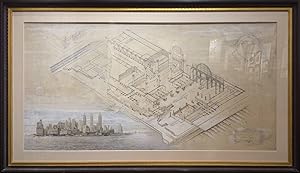Magnanti Angelo Hawley Hughson (1 results)
Product Type
- All Product Types
- Books
- Magazines & Periodicals
- Comics
- Sheet Music
- Art, Prints & Posters
- Photographs
- Maps
-
Manuscripts &
Paper Collectibles (1)
Condition
- All Conditions
- New
- Used
Binding
- All Bindings
- Hardcover
- Softcover
Collectible Attributes
- First Edition
- Signed
- Dust Jacket
- Seller-Supplied Images
- Not Printed On Demand
Seller Location
Seller Rating
-
Pennsylvania Station New York WITH Pennsylvania Station, New York City Seventh Avenue and Thirty-Second Street
Published by New York, 1946
Seller: Arader Books, New York, NY, U.S.A.
Manuscript / Paper Collectible First Edition
No binding. Condition: Very good. First. THE BIRTH AND DEATH OF THE GREATEST BEAUX-ARTS BUILDING IN AMERICA. Magnanti, Angelo. Pennsylvania Station New York. New York: for McKim, Mead & White; ca. 1946. Graphite, ink and gouache on artist's board (visible: 63" x 32" visible, frame: 73 1/2" x 42 1/2"). A little foxing; not viewed out of frame. WITH Hughson, Hawley (after). Pennsylvania Station, New York City Seventh Avenue and Thirty-Second Street. Philadelphia: Ketterlinus for the Pennsylvania Railroad Co., 1910. Offset chromolithograph on card (sheet: 33 1/4" x 57 1/2", frame: 39 1/2" x 61 3/4"). Water damage to the lower edge, partially matted out. Not viewed out of frame. In 1910, the New York terminus of the Pennsylvania Railroad Company opened on two full blocks between Seventh and Eighth Avenues and West Thirty-First and Thirty-Third Streets. Charles Follen McKim was the lead architect at McKim Mead and White, the firm responsible for some of America's great buildings: the East and West Wings of the White House, Symphony Hall in Boston, the major clubs of New York (Century, Metropolitan, University, Harvard, Harmonie, Racquet & Tennis). The original Penn Station was considered the greatest of them all, a towering monument to American wealth, mobility and progress. Hawley Hughson (1850-1936) was born in London but became one of the preeminent chroniclers of American buildings. Although romanticized, his building portraits and panoramas are among the best documents of a period of rapid change that shaped the cities of the United States. His depiction of the brand-new Penn Station is among his most recognizable, and documents much of midtown Manhattan (the Plaza Hotel at 59th and Fifth is depicted in part at the left-hand side, the Hotel Martha Washington (now the Redbury on 29th St.) is at the right), as well as Queens and Brooklyn beyond. The skyscrapers were still to come; the tallest building in New York in 1910 was the Metropolitan Life Insurance Building. The station's flow of passengers increased and hit its zenith in 1945-1946, precisely when MMW commissioned the "decorator" Angelo Magnanti (1879-1969) to depict their renovation of the station to accommodate the surge of pedestrian traffic. This would eventually be installed as a mural in the station master's office (other surviving Magnanti murals are at the Dollar Savings Bank, the Frick Art Reference Library and the conference room of the U.S. Supreme Court; he also designed mosaic ceiling at the Williamsburg Savings Bank). The New-York Historical Society in its MMW archives holds a less-developed sketch (2":1' scale) executed in color with gilt, presumably as a proposal to the firm, signed and dated "A. Magnanti/ 1946." The present work is drafted quite precisely, with washes of gouache and ink in a quasi-grisaille depiction of a sectional view of the station. At the lower left is a view of lower Manhattan from the South, rendered in near-photographic accuracy. The combination of the age of air travel and the 1956 Federal Aid Highway Act signed by Eisenhower ended the dominance of railroads. The mural stood in the station-master's office until the destruction of the station in 1963, widely considered one of the great architectural travesties, and the proximate cause of modern historical preservation. The new Penn Station is generally reviled; only in 2021 was the sin somewhat redeemed with the opening of the Moynihan Train Hall in the James A. Farley Building across Eighth Ave. -- luckily also designed by McKim, Mead & White. The Magnanti drawing was acquired from the Swann "New York Sale" (lot 306) that took place just two weeks after September 11th, 2001. The Hughson chromolithograph was acquired at Bonham's New York 10 December 2014 (lot 197).


